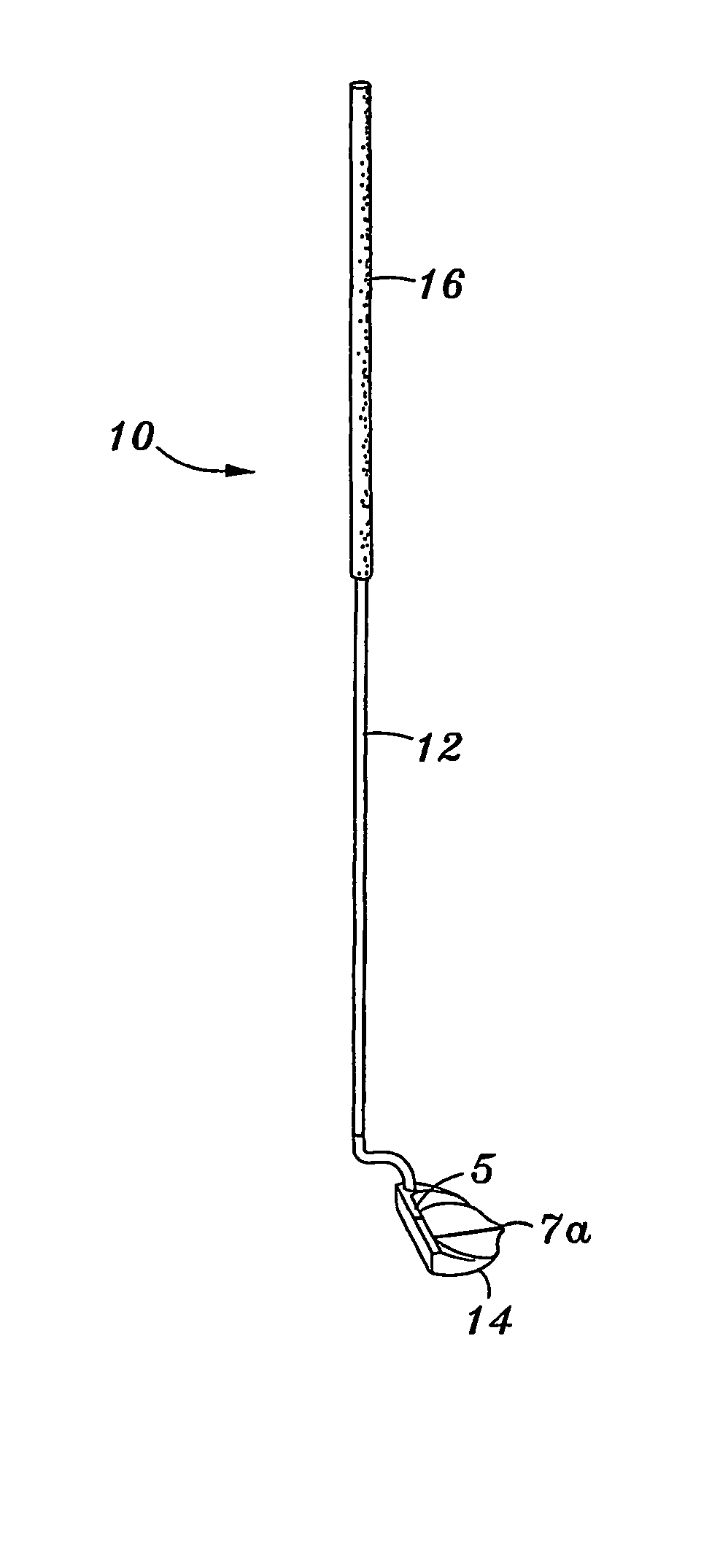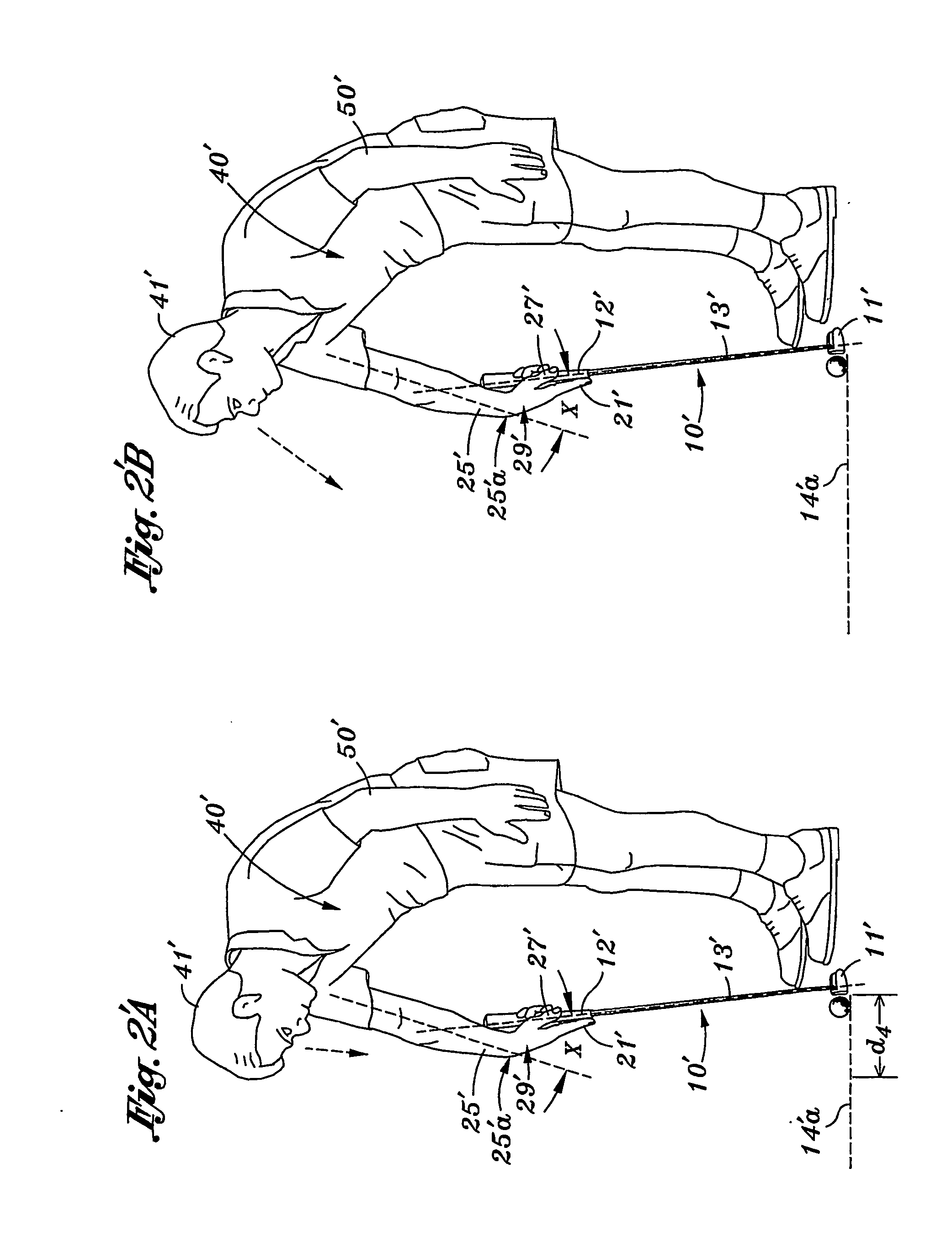Putting method and putter
a technology which is applied in the field of putting method and putter, can solve the problems of unneeded and unwanted leverage of body joints, inconvenient use of body joints, and considerable force to putt a ball over those surfaces
- Summary
- Abstract
- Description
- Claims
- Application Information
AI Technical Summary
Problems solved by technology
Method used
Image
Examples
first embodiment
A First Embodiment
Introduction
[0138] In the first embodiment of this invention, a normally dominant right-handed golfer uses a putter 10' that is a variation of a conventional left-handed putter. The putter 10' has the top end of its grip widened as shown in FIG. 5'A and FIGS. 9' through 12'. It includes a head 11' connected by a shaft 13' to a grip 12'. Preferably, the top end 12'a of the grip 12' of the putter 10' is widened to facilitate the one-hand and arm putting method of this invention, but the method of this invention is not limited to using this type of modified grip. In other words, the putter 10' has its grip modified to better practice the method of this invention, but its head 11' is oriented in the same manner as a conventional left handed putter.
[0139] As depicted in FIG. 5'A and FIGS. 9' through 12', the upper portion 8' of the grip 12' tapers inward to merge with a lower portion 7' having dimensions less than the dimensions of the upper portion. The upper portion 8...
second embodiment
A Second Embodiment
[0196] THE PUTTER. The putter, which is specifically designed and has unique properties for use with this second embodiment of the putting method of this invention, is critical to the successful execution of this second embodiment.
[0197] As best shown in FIGS. 1, 1A, 2, 2B and 4, the putter 10 used in the second embodiment of this invention has an elongated shaft 12, a putter head 14 at the distal end of the shaft 12, and a grip 16 covering the proximal end of the shaft 12. The grip 16 covers more than one-third of the shaft 12, and is approximately two feet in length. Preferably, the grip 16 is cylindrical, or elliptical in shape as shown in FIG. 1B. The putter head 14 has a faceplate 5 with an edge 5a that may be used to align the putt as discussed subsequently. There are opposed downward slopping walls 6a and 6b extending rearward from the faceplate that taper into and terminate along a trailing edge 7b of a sole plate 7. The forward end of this sole plate 7 is...
third embodiment
A Third Embodiment
[0336] A third embodiment of this invention uses the putter 10 shown in FIGS. 1 and 1A. In this third embodiment, the golfer grasps the grip 16 with his right hand and right arm in the same manner as in the second embodiment and swings the putter 10 in the same manner as in the second embodiment, maintaining the positional relationship of the right hand, arm and putter. In this third embodiment, however, the left hand is also used to grasp the putter 10. The use of both hands substantially improves control of the putt.
[0337] BOTH HANDS AND ARMS HOLD THE PUTTER. The dominant hand and dominant arm are used to securely hold and control the putter through the use of multiple contacts with the grip, and the non-dominant hand and arm provide additional control and power. The mechanics of the putting stroke are thereby simplified, more easily performed and result in more accurate and consistent putting.
[0338] Using for example the putter 10 shown in FIG. 1, the golfer fir...
PUM
 Login to View More
Login to View More Abstract
Description
Claims
Application Information
 Login to View More
Login to View More - R&D
- Intellectual Property
- Life Sciences
- Materials
- Tech Scout
- Unparalleled Data Quality
- Higher Quality Content
- 60% Fewer Hallucinations
Browse by: Latest US Patents, China's latest patents, Technical Efficacy Thesaurus, Application Domain, Technology Topic, Popular Technical Reports.
© 2025 PatSnap. All rights reserved.Legal|Privacy policy|Modern Slavery Act Transparency Statement|Sitemap|About US| Contact US: help@patsnap.com



